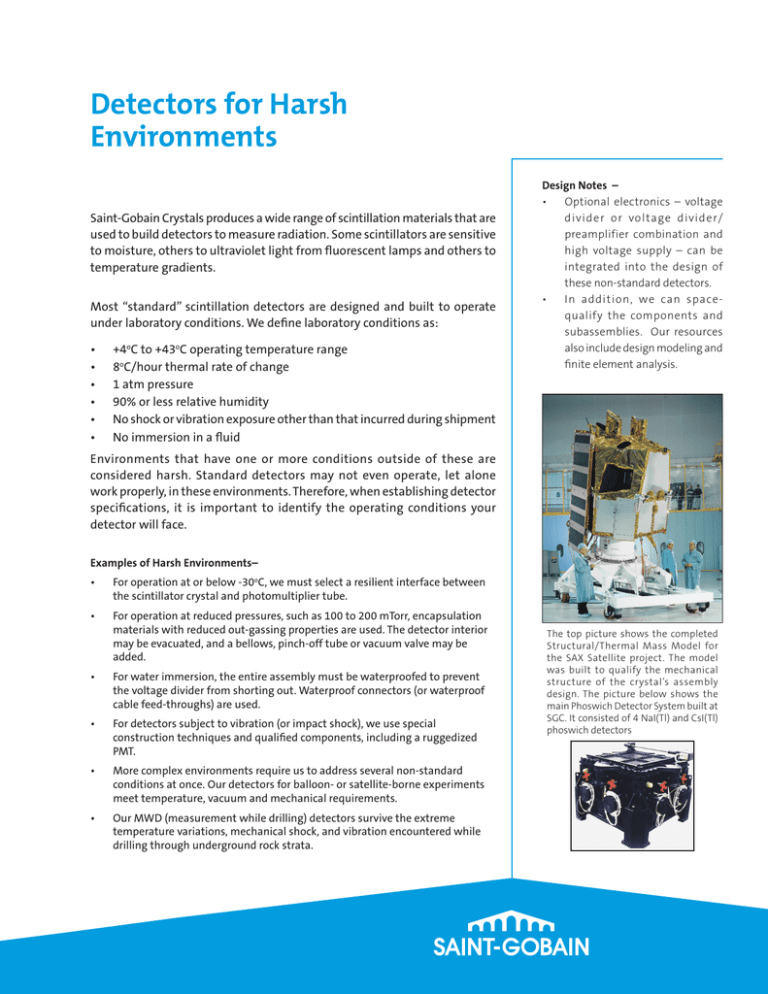
Detectors for Harsh
Environments
Saint-Gobain Crystals produces a wide range of scintillation materials that are
used to build detectors to measure radiation. Some scintillators are sensitive
to moisture, others to ultraviolet light from fluorescent lamps and others to
temperature gradients.
Most “standard” scintillation detectors are designed and built to operate
under laboratory conditions. We define laboratory conditions as:
•
•
•
•
•
•
+4oC to +43oC operating temperature range
8oC/hour thermal rate of change
1 atm pressure
90% or less relative humidity
No shock or vibration exposure other than that incurred during shipment
No immersion in a fluid
Design Notes –
• Optional electronics – voltage
divider or voltage divider/
preamplifier combination and
high voltage supply – can be
integrated into the design of
these non-standard detectors.
• In addition, we can spacequalify the components and
subassemblies. Our resources
also include design modeling and
finite element analysis. Environments that have one or more conditions outside of these are
considered harsh. Standard detectors may not even operate, let alone
work properly, in these environments. Therefore, when establishing detector
specifications, it is important to identify the operating conditions your
detector will face.
Examples of Harsh Environments–
•
For operation at or below -30oC, we must select a resilient interface between
the scintillator crystal and photomultiplier tube.
•
For operation at reduced pressures, such as 100 to 200 mTorr, encapsulation
materials with reduced out-gassing properties are used. The detector interior
may be evacuated, and a bellows, pinch-off tube or vacuum valve may be
added.
•
For water immersion, the entire assembly must be waterproofed to prevent
the voltage divider from shorting out. Waterproof connectors (or waterproof
cable feed-throughs) are used.
•
For detectors subject to vibration (or impact shock), we use special
construction techniques and qualified components, including a ruggedized
PMT.
•
More complex environments require us to address several non-standard
conditions at once. Our detectors for balloon- or satellite-borne experiments
meet temperature, vacuum and mechanical requirements.
•
Our MWD (measurement while drilling) detectors survive the extreme
temperature variations, mechanical shock, and vibration encountered while
drilling through underground rock strata.
The top picture shows the completed
Structural/Thermal Mass Model for
the SAX Satellite project. The model
was built to qualify the mechanical
structure of the crystal’s assembly
design. The picture below shows the
main Phoswich Detector System built at
SGC. It consisted of 4 NaI(Tl) and CsI(Tl)
phoswich detectors
Detectors for
Harsh Environments
USA
Saint-Gobain Crystals
17900 Great Lakes Parkway
Hiram, OH 44234
Tel: (440) 834-5600
Fax: (440) 834-7680
Europe
Saint-Gobain Crystals
104 Route de Larchant
BP 521
77794 Nemours Cedex, France
Tel: 33 (1) 64 45 10 10
Fax: 33 (1) 64 45 10 01
P.O. Box 3093
3760 DB Soest
The Netherlands
Tel: 31 35 60 29 700
Fax: 31 35 60 29 214
Japan
Saint-Gobain KK, Crystals Division
3-7, Kojimachi, Chiyoda-ku,
Tokyo 102-0083 Japan
Tel: 81 (0) 3 3263 0559
Fax: 81 (0) 3 5212 2196
China
Saint-Gobain (China) Investment
Co, Ltd
15-01 CITIC Building
19 Jianguomenwai Ave.
Beijing 100004 China
Tel: 86 (0) 10 6513 0311
Fax: 86 (0) 10 6512 9843
India
Saint-Gobain Crystals and
Detectors
Sy. No. 171/2, Maruthi Industrial
Estate
Hoody Rajapalya, Whitefield Main
Road
Bangalore 560048 India
Tel: 91 80 42468989
Fax: 91 80 28416501
www.crystals.saint-gobain.com
Manufacturer reserves the right to alter specifications.
©2002 -14 Saint-Gobain Ceramics & Plastics, Inc. All rights reserved.
(05-14)




